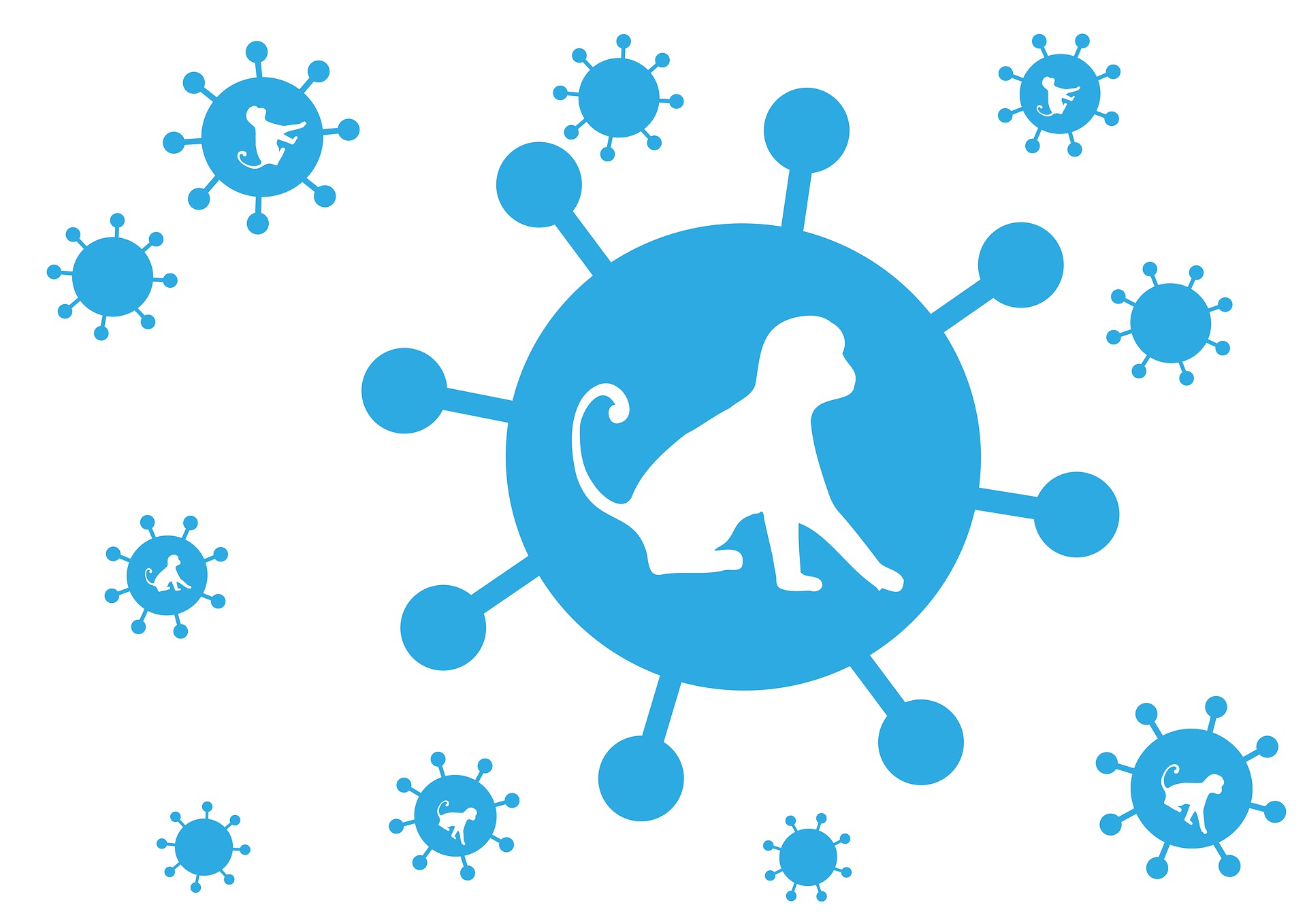Since May 2022, more and more cases of infection with the monkeypox virus have been occurring worldwide. We explain where the virus comes from and how dangerous it is here.
What is monkeypox?
Monkeypox is a rare viral disease, usually transmitted from animals to humans, circulating mainly in African countries. The first case was identified in 1970 in a nine-month-old boy in Congo. Since then, more minor epidemics have occurred in Central and West Africa from time to time. So far, only very isolated cases have occurred outside the African continent: 2003 saw the first detection of monkeypox in the USA. About 70 people became infected during this outbreak. The cause was identified as importing rodents from Ghana into the USA. Later cases also occurred in the UK and Israel (2018), Singapore (2019), and again in the US (2021).
Outbreaks in Central and West Africa have occurred primarily through the transmission of the virus from animals to humans. Thus, the disease also bears monkeypox because the pathogen was first detected in macaques in a Danish laboratory in 1958. However, experts suspect that the virus circulates in squirrels, rats, and mice. Monkeys – just like humans, by the way – are considered to be so-called false hosts. An incorrect host can be infected, but a parasite, for example, cannot develop further in it. “Nevertheless, false hosts can become more seriously ill than the actual host since the organism is not adapted to the pathogen,” explains virologist and smallpox expert Ingo Drexler from the University Hospital in Düsseldorf.
So far, two different variants of the monkeypox virus have been identified: The Central African and the West African variant. The West African variant is considered less contagious and has a milder course.
How fast does the monkeypox virus spread?
In connection with the current increased outbreaks outside the African continent, the first case in England became known in early May. A man had contracted the disease during a trip to Nigeria.
Since then, more and more countries in Europe and North America have reported cases of monkeypox, including Portugal, Spain, Italy, the Netherlands, Belgium, France, Germany, Canada, and the United States. Individual cases have also occurred in the United Arab Emirates and Australia. The Global Health Data Science initiative reported a total of 332 confirmed cases in 22 different countries outside the endemic areas of Africa at the end of May. What is unique about this time is that these cases are not due to travel to Central or West Africa, according to Robert Koch Institute in Germany. Instead, many transmissions occurred in the context of sexual activities (currently, especially among men who had sexual contact with other men).
Why is monkeypox spreading worldwide right now?
At a press conference at the German Medical Congress in Bremen, Health Minister Karl Lauterbach suspects that people’s susceptibility may have changed – or the pathogen itself. Infectiologist Leif Erik Sander of Charité Berlin tweeted on May 19 that declining population immunity since the end of smallpox vaccinations could be contributing to the current monkeypox outbreaks. In addition, the attack may indicate altered human-to-human transmissibility of the virus, Leif Erik Sander said.
At the same time, the virus appears to be far less mutation-prone than the coronavirus, Clemens Wendtner, an infectiologist at Munich Hospital Schwabing, told the Science Media Center Press Briefing. So what causes are responsible for the current outbreaks needs to be clarified in further investigations.
How does monkeypox virus transmission occur?
In endemic areas in Central and West Africa, the virus has been transmitted to humans primarily through contact with infected animals, mainly squirrels and rodents, and monkeys. This can occur when there is closer contact with the animals and their secretions, such as through bites, hunting, or eating inadequately heated meat from infected animals.
However, the outbreaks outside the African continent are probably predominantly due to human-to-human transmission. This requires close physical contact, according to current knowledge.
Contact with body fluids: Transmission can occur upon contact with an infected person’s body fluids, such as blood or saliva.
Contact with skin rash: The skin rash or crust typical of monkeypox is also considered infectious.
Large respiratory droplets: Prolonged close personal contact is necessary for airborne infection to occur because these droplets cannot travel far. As happens with coronavirus, Aerosol transmission is unlikely given the current meager transmission rate.
Smear infections: Thus, one can become infected through clothing, bed linen, towels, or dishes used by the infected person.
Since there has been an increase in cases among men who have had sex with other men, investigations are still underway to determine whether the virus can also be spread via direct sexual transmission routes (e.g., through semen or vaginal secretions). The entry point can be the minor skin lesions and all mucous membranes (eye, mouth, nose, genitals, anus).
For monkeypox, what is the risk of infection to the general population?
According to the current state of knowledge, the WHO and the British health authority estimate the risk of infection for the general population as low. This is because transmission only takes place through close physical contact.
Therefore, especially people in close contact with an infectious person, such as sexual partners, household members, and healthcare professionals, are exposed to a higher risk of infection.
Older people, in particular, are likely to be at low risk, as they are still protected by smallpox vaccination.
Are primarily homosexual or bisexual men affected by monkeypox?
The current outbreaks in May have increasingly affected men who have had sex with other men. However, the risk of infection is not limited to these groups of people. Anyone who has close physical contact with an infectious person is at stake.
“Currently, homosexual or bisexual men could become increasingly infected since the virus was probably initially introduced into this group and has now first been transmitted further there through close contact,” says Ingo Drexler, virologist, and smallpox expert at the University Hospital in Düsseldorf.
The EU health authority ECDC estimates that infection is high for people – regardless of gender – who generally have many sexual partners.
What are the symptoms of monkeypox?
Five to 21 days after infection, the first symptoms usually appear, including fever, headache, muscle pain, and swollen lymph nodes. A rash usually develops then, often starting on the face, hands, and forearms and spreading to other body parts. The rash looks different depending on the phase and sometimes resembles chickenpox and syphilis. Affected individuals usually recover after 2-4 weeks.
There is already initial evidence from sequencing the virus in Portugal that the current outbreaks are the West African variant of the monkeypox virus. This is considered less contagious and shows milder disease progression than the Central African variant of the monkeypox virus.
Is monkeypox fatal?
Monkeypox can also result in severe courses. Especially in severely immunocompromised people, fatal illnesses are also possible due to a bacterial skin infection, pneumonia, or brain inflammation. Consequences of surviving disease can include scarring and, rarely, blindness.
In the West African variant – which is presumably currently circulating in Europe – a mortality rate of one percent has been observed, which is many times lower than the mortality rate of the Central African variant (up to 11 percent in children). Because of better health care, mortality in our country is probably even lower.
Only mild courses have been observed in the outbreaks outside the African endemic areas and the low infection rate.
Is monkeypox particularly dangerous for children?
So far, only infections among adults are known in the current outbreaks outside of Africa. In principle, however, all age groups and genders are equally susceptible. However, data from Africa show that children under 16 years of age – especially immunocompromised infants – have an increased risk of a severe course. Whether this observation can also be applied to the outbreaks in Europe is still unclear. Differences in health care could also have an influence here.
Is monkeypox particularly dangerous for pregnant women?
According to the EU health authority ECDC, pregnant women are at increased risk of a severe course. Transmission in pregnant women via the placenta to the fetus has also been described in African endemic areas.
Is there any treatment against monkeypox?
Preventing bacterial superinfection is essential. A drug developed to treat smallpox virus infections was recently approved in the EU to treat monkeypox (Tecovirimat).
Do infected people with monkeypox have to be quarantined?
There is no official quarantine regulation so far. However, the RKI recommends that infected persons isolate themselves in a room until the rash has subsided and the smallpox crusts have fallen off, but for at least 21 days.
Bedding and household items should also not be shared with other people. The monkeypox virus can survive several days to months on surfaces or fabrics.
Is there a vaccination against monkeypox?
There is no vaccine specifically against monkeypox. However, because of the similarity of the viruses, smallpox vaccines also protect against monkeypox. Virologist Leif Erik Sander of the Charité Berlin speaks on Twitter of smallpox vaccination having a protective effect of 85 percent against monkeypox. This protective effect is also cited by the U.S. Department of Health and Human Services (CDC).
The majority of the older generation is still well protected by the smallpox vaccination, which was still mandatory.
In the wake of the current monkeypox outbreaks, there is no discussion about whether smallpox vaccination should be recommended again for younger immunocompromised people. So-called ring vaccinations are also being discussed – that is, the environment of sick people being vaccinated explicitly against smallpox.
The smallpox vaccine is better today than it was then.
The smallpox vaccine Imvanex, which contains modified vaccinia virus Ankara and is better tolerated than older smallpox vaccines, has been licensed in the EU since 2013.
British health authorities have already given more than 1,000 doses of the smallpox vaccine Imvanex to contacts of infected people since the increased incidence of monkeypox. The U.S. is also already preparing to vaccinate close contacts against monkeypox. (As of 5/27/2022)
Could the monkeypox virus lead to a new pandemic?
Both monkeypox virus and coronavirus are zoonotic diseases, meaning they are diseases transmissible from animals to humans. Nevertheless, the initial situation of the two pathogens turns out to be very different:
Compared to the coronavirus, the monkeypox virus is not new. Moreover, since transmission occurs only via close physical contact – and not via aerosols in the air, as with the coronavirus – a significant outbreak is very unlikely. Experts agree on this.
In Central and West Africa, outbreaks caused by transmission from animals to humans have also led to isolated, more minor epidemics with a few hundred infected people.
sources:
- Antworten auf häufig gestellte Fragen zu Affenpocken (RKI, Stand: 27.5.2022)
- Internationaler Affenpocken-Ausbruch: Einschätzung der Situation in Deutschland (RKI, Stand: 25.5.2022)
- Monkeypox cases confirmed in England – latest updates (UK Health Security Agency, Stand 26.5.2022)
- Monkeypox – Key facts (WHO, Stand 19.5.2022)
- Monkeypox Tracker (Global Health – a Data Science Initiative, Stand 27.5.02022)
- Max Kozlov: Monkeypox goes global: why scientists are on alert (Nature, 20.5.2022)
- Risk assessment: Monkeypox multi-country outbreak (ECDC, 23.5.2022)
- Monkeypox cases reported in UK and Portugal (ECDC, 19.5.2022)
- Erik Leif Sanders, Virologe an der Charité Berlin (Twitter, 19.5.2022)
- Monkeypox and Smallpox Vaccine Guidance (CDC, Stand 2.12.2019)
- Britische Gesundheitsbehörde: Mehr als 1.000 Pockenimpfungen verabreicht (24.5.2022)
- USA bereiten Impfungen gegen Affenpocken für Kontaktpersonen vor (Ärzteblatt, 24.5.2022)
- Affenpocken in Deutschland: Muss man sich Sorgen machen?(Bundesministerium für Bildung und Forschung, 25.5.2022)
- Internationaler Ausbruch von Affenpocken (Science Media Center, 20.5.2022)
- Affenpocken – Verbreitungsdynamik, Gegenmaßnahmen und Therapieoptionen (Science Media Center, 27.5.2022)
- Affenpockenvirus: Das wissen wir – und das nicht – quarks.de
picture: pixabay.com
This post has already been read 1138 times!



